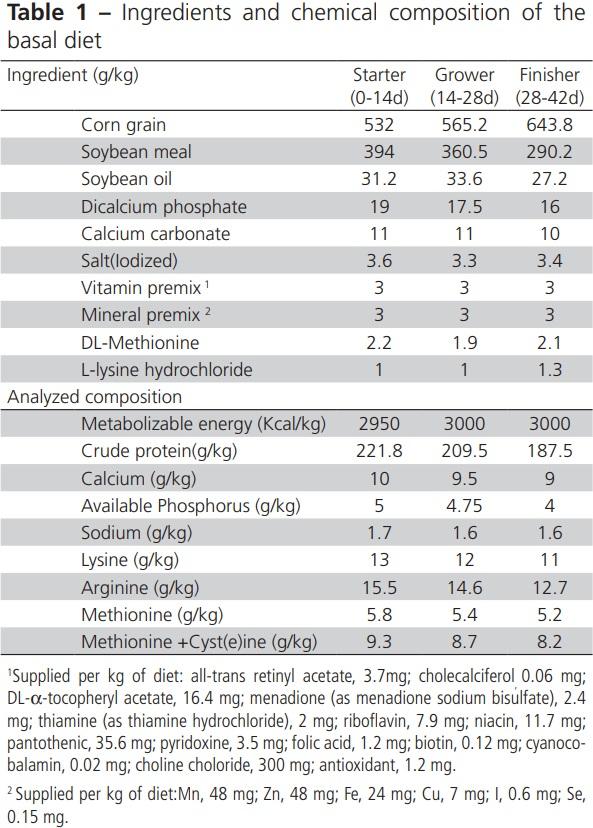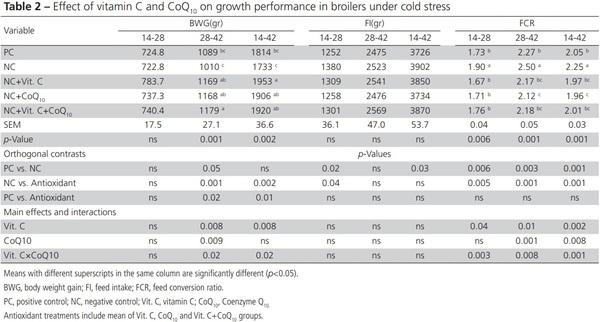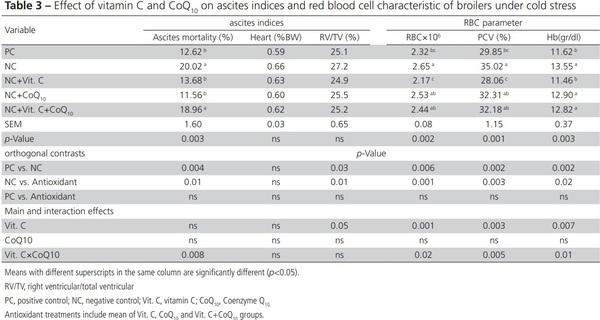INTRODUCTION
The rapid growth of modern broilers in a relatively short period of time requires a parallel increase in the size or capacity of supply organs, such as those of the cardiovascular and respiratory systems. However, due to the slower development of these organs relative to body growth rate, the capacity to balance body energy is compromised, particularly under extreme environment conditions, such as cold stress (Shahir et al., 2012; Shinder, 2002).
Cold environmental temperatures tend to increase blood triiodothyronine (T3) levels, required for the generation of additional metabolic heat to maintain body temperature in colder environments. The subsequent increase in basal metabolic rate results in an increase in oxygen demand and the heart attempts to maintain oxygen supply to the organs and muscles, thus chronically leading to pulmonary hypertension syndrome (PHS), right ventricular hypertrophy, ascites or water belly, and eventually death (Gupta, 2011).
According to Currie (1999) the main reasons of the etiology of ascites could be classified as: pulmonary hypertension, cardiac pathologies, and cellular damage due to oxidative stress caused by increased reactive oxygen species (ROS) production. Enkvetchakul et al. (1993) verified that chickens with ascites suffered from high oxidative stress. Mitochondrial electron leak and ROS production are increased during hypoxia and ascites (Dawson et al., 1993). Tang et al. (2002) also reported high electron leakage in the mitochondria of heart of broilers developing ascites.
As a result of oxidative stress, major antioxidants, such as glutathione, α-tocopherol, and ascorbic acid are reduced in the liver and the lungs of broilers with PHS (Enkvetchakul et al., 1993; Bottje & Wideman, 1995). Vitamin E (Vit. E), vitamin C (Vit. C), coenzyme Q (CoQ), and other antioxidants have beneficial effects as they scavenge free radicals (Gupta, 2011, Ruiz -Feria, 2009). Vit. C at 500 ppm reduced mortality due to PHS induced by cold environmental temperatures (Hassnzadeh et al., 1997). The supplementation of Vit. C at 150 to 450 ppm was also shown to reduce the incidence of ascites caused by feeding extremely high dietary levels of NaCl to broilers (AlTaweil & Kassab, 1990). Broilers submitted to heat stress and supplemented with Vit. C presented better performance, as well as lower plasma corticosterone and higher thyroid hormone levels compared with non-supplemented birds (McKee et al., 1997).
Coenzyme Q10 (CoQ10) is an essential component of the respiratory chain in the inner mitochondrial membrane, and functions as an electron and proton carrier, stimulating ATP synthesis. In addition, its reduced form – CoQH2 (ubiquinol) – can act as an important antioxidant, lowering the accumulation of free radicals, particularly of ROS, thereby reducing peroxidative damage to the body (Forsmark-Andrée et al., 1997). Nakamura (1996) fed diets supplemented with coenzyme Q9, an analogue of CoQ10, at 40 mg/ kg to broiler chicks and showed that dietary coenzyme Q9 supplementation reduced the incidence of ascites.
We hypothesized that CoQ10 and Vit. C supplementation to broilers could alleviate the negative effects of cold stress at mitochondrial and cytosolic level, respectively. To the authors’ knowledge, there is no information on the combined effects of the supplementation of Vit. C and CoQ10 on the performance, blood biochemical parameters, and incidence of ascites of broiler chickens reared under ascites-inducing condition.
MATERIALS AND METHODS
Five hundred male broiler chicks (Hybro) were placed in two environmentally-controlled houses on floor pens (1.3m × 3m) on the day of hatch. Birds were distributed according in a completely randomized design with five treatments, with five replicates (pens) of 20 birds each. The treatments included: positive control (PC, normal rearing conditions and no antioxidant supplementation), negative control (NC, cold stress and no antioxidant supplementation), or cold stress and supplementation of Vit. C (NC+Vit. C, 300 mg/kg of ascorbic acid, DSM), CoQ10 (NC+ CoQ10, 40 mg/kg of coenzyme Q10 provided by Summit AGRO International Ltd., Japan), or Vit. C + CoQ10 (NC+Vit. C+CoQ10, combination of both antioxidants at the same levels). To induce ascites, cold stress started from 15d of age to the end of experiment, time of exposed 24 h. The starter (0-14 d), grower (14-28 d), and finisher (28- 42 d) experimental diets were mixed in single batches (Table 1). The experimental procedures were approved by the Animal Science Research Institution.

All broilers were brooded under the temperatures recommended by the genetic company manual (Hybro) until 14 d of age. The cold-stress protocol of Ruiz-Feria (2009) was applied with slight modifications to promote ascites. Briefly, broilers in the cold-stress groups were subjected between days 15 to 21 to a gradual temperature decline down to 15 ºC, which remained constant until day 42, despite slight fluctuations (less than ± 2 ºC). Positive-control birds (100 birds in five replicates) were reared under the recommended temperature (23-25 ºC) between 21 and 42 days of age. Feed and water were provided ad libitum. A photoperiod of 23L:1D was applied.
Live performance parameters
Weekly feed intake (FI) and body weight gain (BWG) were measured. Mortality was daily recorded, and the dead birds were weighed and necropsied for the presence of water accumulation in the abdomen, which was considered as ascites. Only the heart of the dead birds with ascites lesions was removed and weighed. The right ventricle (RV) was carefully sectioned, separated from the left ventricle and weighed. The RV:TV (total ventricular) ratio was calculated. At the end of experiment (42 days of age), eight birds per treatment were sacrificed, and their RV:TV ratios calculated.
Red blood cells, hematocrit and hemoglobin
At 35 days of age, 2.5mL blood samples were collected from the wing vein of five birds per treatment in EDTA-containing tubes. Red blood cells were counted under light hemocytometer. Hematocrit was measured in capillary tubes and hemoglobin concentration was determined by the ICSH method (International Committee for Standardization in Hematology).
Blood biochemical parameters
At the end of experiment (42 days of age) eight birds per treatment were selected for blood collection, as described above. The serum was separated by centrifugation and used to determine blood biochemical parameters. Thyroid hormone (T4 and T3) levels were determined by enzyme linked immuno sorbent assay (ELISA) using commercial kits (Monobind Inc., USA).
Statistical analysis
Data were analyzed according to completely randomized experimental design was applied. Data were analyzed by the general linear model procedure of SAS® software (SAS 9.1, 2003). In the cold stress condition, a 2×2 factorial arrangement was applied, consisting of the supplementation or not of any of the antioxidants and their levels. The differences among treatments were evaluated by Tukey’s test. The following model was applied:
Where Yijk is dependent variable; µ is the general mean, and αi and βj are the main effects of Vit. C and CoQ10, respectively, and αβij is interaction between the factors. Orthogonal contrasts were applied to compare the results PC vs. NC, PC vs. antioxidant, and NC vs. antioxidant treatment. Mortality data were analyzed by the GENMOD procedure. Probability levels lower than 0.05 were considered significant, unless otherwise noted.
RESULTS
Live Performance
The birds fed antioxidants (Vit. C, CoQ10, or Vit. C+CoQ10) presented higher BWG than the PC birds (p< 0.01) during the finisher and total periods. This difference is mainly attributed to dietary Vit. C supplementation (p< 0.05). The interaction between Vit. C and CoQ10 showed that Vit. C was only effective when the diet was not supplemented with CoQ10 (p< 0.05). There was no difference in FI among treatment groups during the different rearing phases, except when PC was contrasted with NC. The worst FCR was determined in the NC (p< 0.01) during all evaluated phases, and antioxidant supplementation decreased FCR to levels comparable with the PC treatment. The diet containing only CoQ10 promoted lowest FCR (p< 0.01). The interaction between Vit. C and CoQ10 had a significant effect (p< 0.01) on FCR during all evaluated phases.
Ascites incidence
Higher mortality due to ascites (p< 0.01) was observed in the NC treatment compared with the other treatments (Table 3). The individual supplementation of Vit. C and CoQ10 reduced the mortality due to ascites, but not their combined supplementation to cold-stressed birds). Although no differences in heart weight were not significant among treatments, the NC birds presented the highest value. The RV/TV ratio was relatively higher in NC birds compared with PC birds (p< 0.05), and corresponded to the higher mortality due to ascites in this group.
Red blood cells, packed-cell volume and hemoglobin
Higher red blood cell counts (RBC), packed-cell volume (PCV), and hemoglobin (Hb) levels were determined in the blood of NC birds compared with the PC and PC+Vit. C groups, but were not different from the PC+ CoQ10 and the PC+Vit.C+ CoQ10 groups. The dietary addition of antioxidants reduced both PCV and RBC to the levels comparable with PC. Vit. C addition was quite effective in this regard (p< 0.01), but no synergism was observed between Vit. C andCoQ10.
Thyroid hormones
Thyroxin (T4) levels and triiodothyronine (T3) to thyroxin ratio were affected (p< 0.05) by treatments (Table 4). The PC group presented the highest T4 level and the lowest T3/T4 ratio. The antioxidant addition increased plasma T4 and reduced T3/T4 ratio relative to NC, although, this difference was not significant. Plasma T3 was not affected by treatments.
DISCUSSION
The results indicated that NC birds presented worse performance reduced due to cold stress, which was in agreement with several studies (Mendes et al., 1997; Hangalapura, 2003; Blahova et al., 2007; Ipek & Sahan, 2006; Balog et al., 2003). Cold stress increases the energy requirement for thermoregulation, diverting the available energy for production to maintenance (Hangalapura et al., 2003). Cold-exposed broilers also increase their FI to increase the thermogenic effect of nutrient absorption, assimilation, and utilization (McKee et al., 1997; Collin et al., 2003). Under low environmental temperatures, the activity of the thyroid increases, resulting in high metabolic rate, oxygen consumption, and FI for thermoregulation, which may lead to reduced BWG. The result of present study clearly showed that broilers fed diets with the individual supplementation of Vit. C or CoQ10 presented better performance than the NC birds, but no synergism was observed between these two antioxidants. The effectiveness of Vit. C to improve the performance of broilers under stress was previously demonstrated (Walton, et al., 2001; Ruiz-Feria et al., 2001, 2009). This may be explained by the different roles of Vit. C in the body. Ascorbic acid is required for the synthesis of collagen, carnitine, corticosterone, and several neurotransmitters. It is also involved in the metabolism of tyrosine, iron, and thyroid hormones. More importantly, it is a powerful antioxidant and its ability to protect lipids against peroxidation in plasma is higher than vitamin E (McDowell, 2000). Vit. C is not regarded as a dietary requirement for poultry because it has been postulated that it can be synthesized at a sufficient rate to meet the needs under normal rearing conditions. However, there is evidence of lower endogenous Vit. C production in young relative to adult broilers (Leeson & Summers, 2001).
CoQ10, as a necessary component of the respiratory chain in the inner mitochondrial membrane, not only functions as an electron and proton carrier and drives ATP synthesis, but its reduced form (CoQH2 – ubiquinol) may act as an important antioxidant to reduce the accumulation of free radicals, particularly of ROS, and alleviate the peroxidative damage to the body. It can also act as a non-specific stimulant of immune host defense system (Geng et al., 2007). The observed growth-promoting effect of CoQ10 under ascites-inducing conditions in the present study was comparable with the results of Nakamura et al. (1996) and Geng et al. (2004).
Ascites indices
The experimental procedure was successful to induce ascites, as shown by the highest mortality rate due to ascites of NC birds. Cold temperatures increase the incidence of ascites by increasing both metabolic oxygen requirements and pulmonary hypertension (Bendheim et al., 1992; Julian et al., 1989; Stolz et al., 1992). Oxidative stress due to increased ROS production from mitochondrial electron leak is one of the main causes of the etiology of ascites in poultry exposed to cold temperatures (Currie, 1999). In the present study, mortality due to ascites and the RV/TV ratio in the groups supplemented with Vit. C or CoQ10 were reduced to comparable PC levels, which indicates the significant role of these anti-oxidative substances in the occurrence of ascites (Geng et al., 2004).
Our findings are consistent with those of Nakamura et al. (1996) and Geng et al. (2004), who showed that dietary Q9 or Q10 supplementation, respectively, was effective in reducing the incidence of ascites in broilers. Those authors suggested that CoQ10 protects cardiac myocytes by supplying enough energy, in the form of ATP, for the cardiac muscle. Ubiquinol, the reduced form of CoQ10, can function as an antioxidant in blood to protect the erythrocyte membrane structure, increase their deformability and transportation ability, and hence, reduce mortality due to ascites (Geng et al., 2004).
Red blood cell counts, PCV values and hemoglobin levels were significantly increased in NC birds and reduced by Vit. C supplementation. These findings are consistent with the Blahva et al. (2007), Yahav (1999), Ipek & Sahan (2006). Under low environmental temperatures, broilers are forced to increase their metabolic rate. More erythrocytes are needed to transport oxygen to meet these increased metabolic needs. The increased oxygen requirement leads to physiological hypoxia, stimulation of erythropoiesis, and eventually increased hematocrit values (Gupta, 2011).
Dietary Vit. C addition returned RBC counts to the normal levels. Continuous increase in corticosterone levels in ascitic chickens resulted in increased production of red blood cells (Baghbanzadeh & Decuypere, 2008). Supplemental Vit. C may reduce plasma corticosterone. A likely mechanism is inhibited by C-21 hydroxylase and 11-b hydroxylase and decreased corticosterone synthesis (McKee et al., 1997).
Thyroid Hormones
The dietary supplementation of Vit. C significantly reduced the mortality due to ascites in broilers, with a concomitant reduction in plasma thyroid hormone levels, suggesting a role of Vit. C in metabolic activity (Hassanzadeh et al., 1997).
Cold stress induces physiological changes that are of high priority and energy demanding in homeotherms. Cold stress alters the function of hypothalamic-pituitarythyroid and adrenal axis, resulting in changes in the circulating levels of thyroid and adrenal hormones. Cold environmental temperatures increase the levels of T3, which is required for the generation of additional metabolic heat to maintain body temperature in cooler environments. The subsequent increase in metabolic rate results in an increase in blood pressure as the heart attempts to maintain the oxygen supply to the organs and muscles, thus leading to pulmonary hypertension, right ventricular failure, and eventually ascites (Julian et al., 1989; Acar et al., 1995; Gupta, 2011).
In conclusion, the production of free radicals in cold stress conditions destroy cell membranes, especially of erythrocytes, changes the circulating levels of thyroid and adrenal hormones, increasing the metabolic rate and the energy requirement for maintenance of broilers, which results in worse performance. Vitamin C and CoQ10 function as antioxidants. Therefore, the supplementation of Vit. C or CoQ10 in the diet of broiler chickens under cold stress conditions improves their performance parameters (body weight and FCR) and ascites-related traits (low red blood cell count, hematocrit, T3, and heart weights, and elevated T4). No significant improvements in these parameters were observed with the combination of Vit. C and CoQ10 relative to their individual application.
This article was originally published in Revista Brasileira de Ciência Avícola, Jul - Sept 2017 / v.19 / n.3 / 537-544. http://dx.doi.org/10.1590/1806-9061-2017-0463. This is an Open Access article distributed under the terms of the Creative Commons Attribution License. 













.jpg&w=3840&q=75)